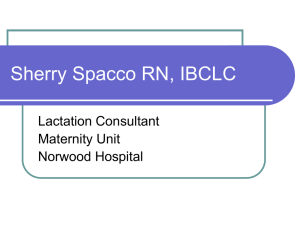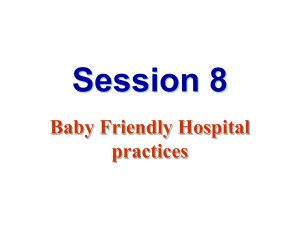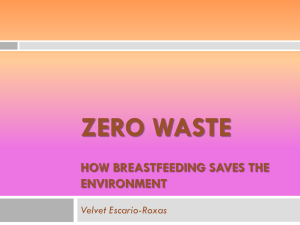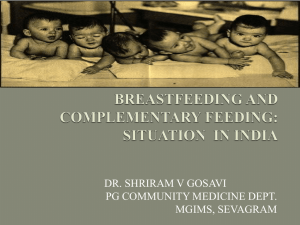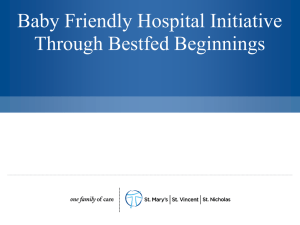Baby Friendly Initiative Grey Bruce Health Services
advertisement
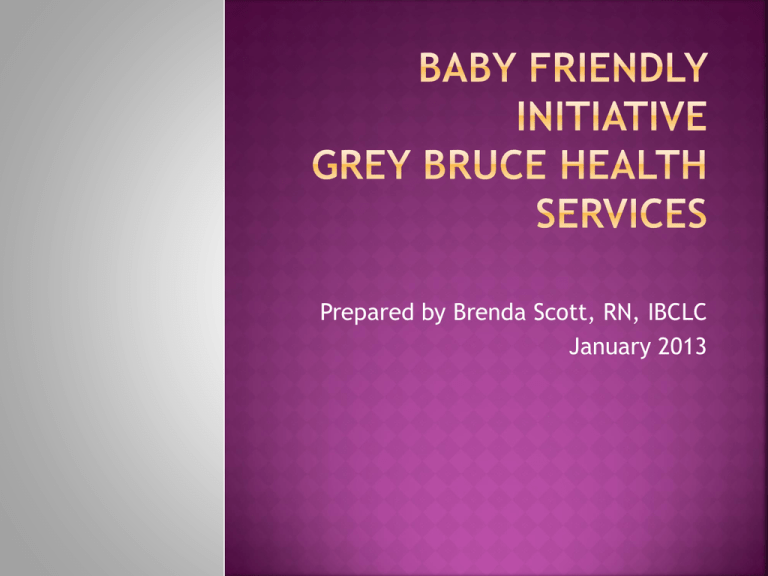
Prepared by Brenda Scott, RN, IBCLC January 2013 “Extensive research using improved epidemiologic methods and modern lab techniques documents diverse and compelling advantages for Infants, Mothers, Families and Society” Policy statement 2005 Pediatrics Reaffirmed 2009 Joint statement Health Canada, Canadian Paed Society, Dietitians of Canada, Breastfeeding Committee of Canada WHO International Code XX or breast milk substitutes Elimination of free breast milk subustitutes i.e. formula Innocenti Declaration on protection, promotion and support of breastfeeding A statement commital the WHO/UNICEF to protect, support and promotion of breastfeeding Baby Friendly Hospital Initiative An initiative encouraging maternity care providers to implement breastfeeding locally and nationally The Severn Point Plan for the protection, promotion and support of breastfeeding Developed by the UK BFI Committeee to encourage breastfeeding implementation among healthcare professionals Is a global evidenced-based standard of care Is a campaign of the WHO/Unicef statement 1991 (shown to increase Breastfeeding rates ) Recognizes that implementing Best practice in Hospital is Critical for support and promotion of EXCULSIVE, LONG-TERM Breastfeeding Best Practice is represented by “The 10 Steps to Successful Breastfeeding” (est. 1989) 1991 Health Canada created the Breastfeeding Committee for Canada 1. 2. 3. 4. 5. 6. 7. 8. 9. 10. Have a written breastfeeding policy that is routinely communicated to all health care staff. Train all health care staff in skills necessary to implement this policy. Inform all pregnant women about the benefits and management of breastfeeding. Help mothers initiate breastfeeding within a half-hour of birth. Show mothers how to breastfeed, and how to maintain lactation even if they should be separated from their infants. Give newborn infants no food or drink other than breastmilk unless medically indicated. Practice rooming-in –allow mothers and infants to remain together -24 hours a day. Encourage breastfeeding of demand. Give no artificial teats or pacifiers (soothers, dummies) to breastfeeding infants. Foster the establishment of breastfeeding support groups and refer mothers to them on discharge from the hospital or clinic. EVERY FACILITY PROVIDING MATERNITY SERVICES AND CARE FOR NEWBORN INFANTS SHOULD FOLLOW THESE TEN STEPS TO SUCCESSFUL BREASTFEEDING Ontario (2008) Initiation rate 88% At 6 months 16-26% Breastfeeding Initiation Rate GBHS (2011): Exclusive Breastfeeding Rate upon Discharge: Supplementation Rate while Breastfeeding at Discharge: PHU Breastfeeding rates: 2 wks 6wks 36 Designated Facilities (8 Hospitals, 25 Community Centres Health Services, 3 Birthing Centres) Quebec 24 Ontario 10 BC 2 Requested Provincial Council for Maternal & Child Health est. an “Expert Panel” to support the delivery of Breastfeeding Services in Ontario RECOMMENDATION- to work toward Implementation of BFI (Breastfeeding Friendly Initiatives) for healthcare providers, administrators, volunteers in hospital regarding policies/practices NEEDED to promote, support breastfeeding EFFECTIVE January 2012 Is referencing BFI practices in its Obstetrical Standards for hospitals, that aligns with the BFI and International Code of Marketing of Breastmilk Substitutes Contributes to Health and development of mother/infant Excellence in family-centred maternity care Quality assurance by meeting international standards Monetary savings for Maternity Units Increased morale and satisfaction of staff/families Increased awareness and support of Breastfeeding within the community Warmer/calmer emotional environment Fewer neonatal infections Less staff time required Improved hospital image and prestige Support, Promote and Protect Breastfeeding by following the Ten Steps to Successful Breastfeeding Adhere to international guidelines outlined in the International Code of Marketing of Breastmilk Substitutes 1. 2. 3. 4. 5. 6. 7. No advertising of products (ie formula) to the public. No FREE Formula samples for mothers. No promotion of products in Health Care facilities, INCLUDING FREE FORMULA. No GIFTS or personal samples to Health Care Workers ie free lunches, pens. No words or pictures idealizing artificial .feeding, including pictures of infants on products. All information on formula including labels should explain the benefits of Breastfeeding & costs/risks of formula feeding. (Brief summary of the Code). Review and update existing Hospital Breastfeeding Policy to include BFI goals as per the 10 steps to Successful Breastfeeding BFI Self Assessment – improvements identified GBHS BFI Breastfeeding Committee reestablished 2012 with Community partners ie PHUnit, Midwives Goal: GBHS Becomes BFI in 2013 Breastfeeding committee for Canada(BCC) 2004. The Ten Steps and Practice Outcome Indicators for Baby-Friendly Hospitals and The Seven Point Plan for the Protection, Promotion and Support of Breastfeeding in community Health Services. Canadian Pediatric Society 9Feb 2008) Nutrition for Healthy term infants. College of Family Physicians of Canada. (2004) Infant Feeding Policy Statement Dietitians of Canada, Canadian Paediatric Society, The College of Family Physicians of Canada & Community Health nurses of Canada (2010) Health Canada (2000) Family-Centered Maternity and Newborn Care: National Guidelines, Ottawa Ministry of Health and Long Term Care (2008) Registered Nurses Association of Ontario (2007) Breastfeeding Best Practice Guidelines for Nurses. Society of Obstetricians and Gynaecologists of Canada, Association of Women’s Health, Obstetric and Neonatal Nurses of Canada, Canadian Association of Midwives, College of Family Physicians of Canada & Society of Rural Physicians of Canada (2008) UNICEF & World Health Organization (2009) Baby-Friendly Hospital Initiative Joint WHO/Unicef Geneva, 1979 World Health Organization. International Code of Marketing of Breast-milk Substitutes Protecting, Promoting and Supporting Breastfeeding. A Joint WHO/Unicef Statement, Geneva, WHO, 1989
